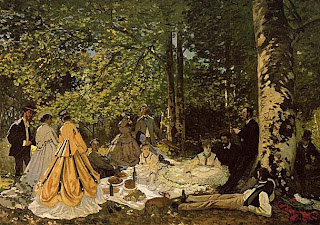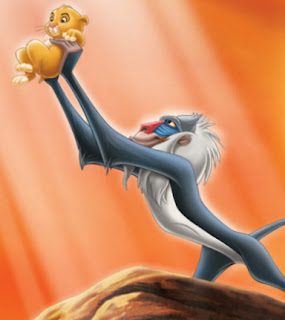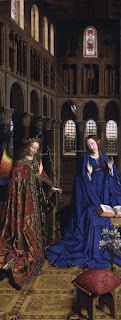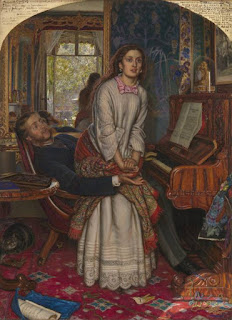Wednesday, December 30th, 2009
I’m preparing a lecture on the Impressionists, and I’ve been completely distracted by Monet’s Déjeuner sur L’Herbe (“Luncheon on the Grass”). Yes – that’s not a typo. I meant to write “Monet,” not “Manet.”
Maybe you’re saying “What?” just like I did fifteen minutes ago. Don’t get too bewildered: Manet DID a very seminal painting that is called Le Déjeuner sur L’Herbe (1863). And Manet’s painting is infinitely more well-known than Monet’s early work with the same title. But allow me to bring Monet’s painting out of obscurity:

Monet,
Le Déjeuner Sur L’Herbe, 1865-66
It’s interesting to see a painting by Monet that includes human figures. (You can see a figure study for this painting
here.) I’m so used to seeing Monet paintings with haystacks and Rouen Cathedrals and water lilies and train stations – it’s so nice to see something different. You also might have noticed that this painting was made just about two years after Manet completed his painting with the same title. A coincidence? Definitely not. There’s no question that Monet was influenced by Manet.
Other painters were also influenced by Manet’s 1863 painting. Cezanne did his own picnicking painting with the same title, and Picasso did several versions that were directly inspired by Manet. In fact, the Musee d’Orsay did an exhibition (which ended in February 2009) that revolved around Picasso’s variations of Manet’s Le Déjeuner sur L’Herbe. Here’s one Picasso example:
 Picasso, Le Déjeuner sur L’Herbe after Manet, 27 February 1960
Picasso, Le Déjeuner sur L’Herbe after Manet, 27 February 1960So, what do you think? Did you know that Monet painted a Déjeuner sur L’Herbe? (I really hope that I’m not the only one who was unaware of that fact.) Which version of the subject matter do you like the best?
Saturday, December 26th, 2009
Here’s my latest art historical hunch. Take a look at the two images below. Does anyone else think that the opening scene of Disney’s cartoon “The Lion King” (1994) was influenced by Eugène Devéria’s Birth of Henry IV (1827)?


I wonder if Disney has ever written about artistic influences for their films. It would be fun to see if there is a statement by Disney that could support my hunch…
Thursday, December 24th, 2009
Christmas art = a smorgasbord. There is so much art associated with Christmas. I would bet there there are over a million different depictions that are associated with the biblical Christmas story. Here are a couple of pieces of Christmas art that I particularly like:

Jan van Eyck,
The Annunciation, c. 1435
My favorite thing about this painting: the awesome rainbow wings on the angel Gabriel. I also love the that Gothic and Renaissance references are combined in the same architectural setting, references the Old and New Testament.

Georges de la Tour,
Adoration of the Shepherds, c. 1644
I particularly love the hand on the right which covers up a candle. Sigh – tenebristic lighting is awesome. I also love the adoring expression of the man on the right.

Brian Kershisnik,
Nativity, 2006
You HAVE to click on the image above to see all of the details in this painting. I saw
Nativity a few years ago, soon after it was completed. This painting is HUGE (about 7′ x 17′), and the viewer can’t help but feel swept into the swarm of angels that swoop around the Holy Family. It’s quite moving.
Do you have a favorite piece of Christmas art?
Merry Christmas and Happy Holidays!
Monday, December 21st, 2009
 Although my mom was never really into art (she said that nude figures made her “embarrassed”), there are a couple of 19th century artists and artistic movements that she liked. It was my mom who first introduced me to the Pre-Raphaelite Brotherhood when I was in high school (or perhaps a freshman in college?). She excitedly pulled me aside, held out a reproduction of The Awakening Conscience (1853, see left) and asked, “Have you heard of the artist William Holman Hunt?”
Although my mom was never really into art (she said that nude figures made her “embarrassed”), there are a couple of 19th century artists and artistic movements that she liked. It was my mom who first introduced me to the Pre-Raphaelite Brotherhood when I was in high school (or perhaps a freshman in college?). She excitedly pulled me aside, held out a reproduction of The Awakening Conscience (1853, see left) and asked, “Have you heard of the artist William Holman Hunt?”
Mom liked Hunt’s art because it was highly religious and moralistic. She liked
The Awakening Conscience because it explored the theme of redemption. This painting depicts a prostitute or mistress who is sitting on the lap of her lover. They are playing the piano together, and it appears the lyrics of the song have pricked the conscience of the young woman. The painting captures this woman’s precise moment of enlightenment and realization. I especially like looking at her expression and knowing that she is staring out an open window (which you can see reflected behind her in a mirror).
There are many moralizing references that are included in the painting. Here is a list of some objects which give clues to the story and moralistic tone of the painting:
– Music on the piano: “Oft in the Stilly Night” is a nostalgic song in which a the singer reflects upon childhood innocence and missed opportunities. (On a side note, this song is mentioned in A Portrait of the Artist as a Young Man by James Joyce – you can listen to the song by going here.)
– Music on the floor: “Tears, Idle Tears” is Edward Lear’s musical adaption of Tennyson’s poem. The sad poem seems to express sorrow over the woman’s predicament. (You can read the poem here).
– Rings: The woman wears rings on all of her fingers except her “wedding finger.”
– Hat and glove: The clothing objects are hastily cast aside, which indicates an abandonment of decorum. Because the hat is placed on the table, it shows that this man is a visitor and not a permanent resident in the house.
– Unraveled threads: A reference to the woman’s wasted life.
– Cat and bird: The cat is chasing a small bird underneath the table. This vignette is a reference to the woman’s predicament (the man = the cat, the woman = the bird).
– Light on the floor: Suggests enlightenment and potential redemption for the woman.
I especially like the inclusion of the cat and bird. Is there any specific object that you like?
The Awakening Conscience will forever remind me of my mother. Did a friend or relative ever introduce you to a work of art? Do you remember the experience?
Friday, December 11th, 2009
 Look closely at this photograph – can you see the man who blends into the background? That man is the artist Liu Bolin. He paints himself to “hide” within his photographs. I just watched this interesting newsclip about Bolin and his work. I think it’s pretty creative stuff. You can read more about the ideology that underlies Bolin’s art (and see more pictures of his work) in this article.
Look closely at this photograph – can you see the man who blends into the background? That man is the artist Liu Bolin. He paints himself to “hide” within his photographs. I just watched this interesting newsclip about Bolin and his work. I think it’s pretty creative stuff. You can read more about the ideology that underlies Bolin’s art (and see more pictures of his work) in this article.
I like how these photographs emphasize the idea that a person is affected by his/her surroundings. I latch onto that idea more than any of the political ideas that influence Bolin, although I think that his artistic/political protest makes sense.
What do you think?





